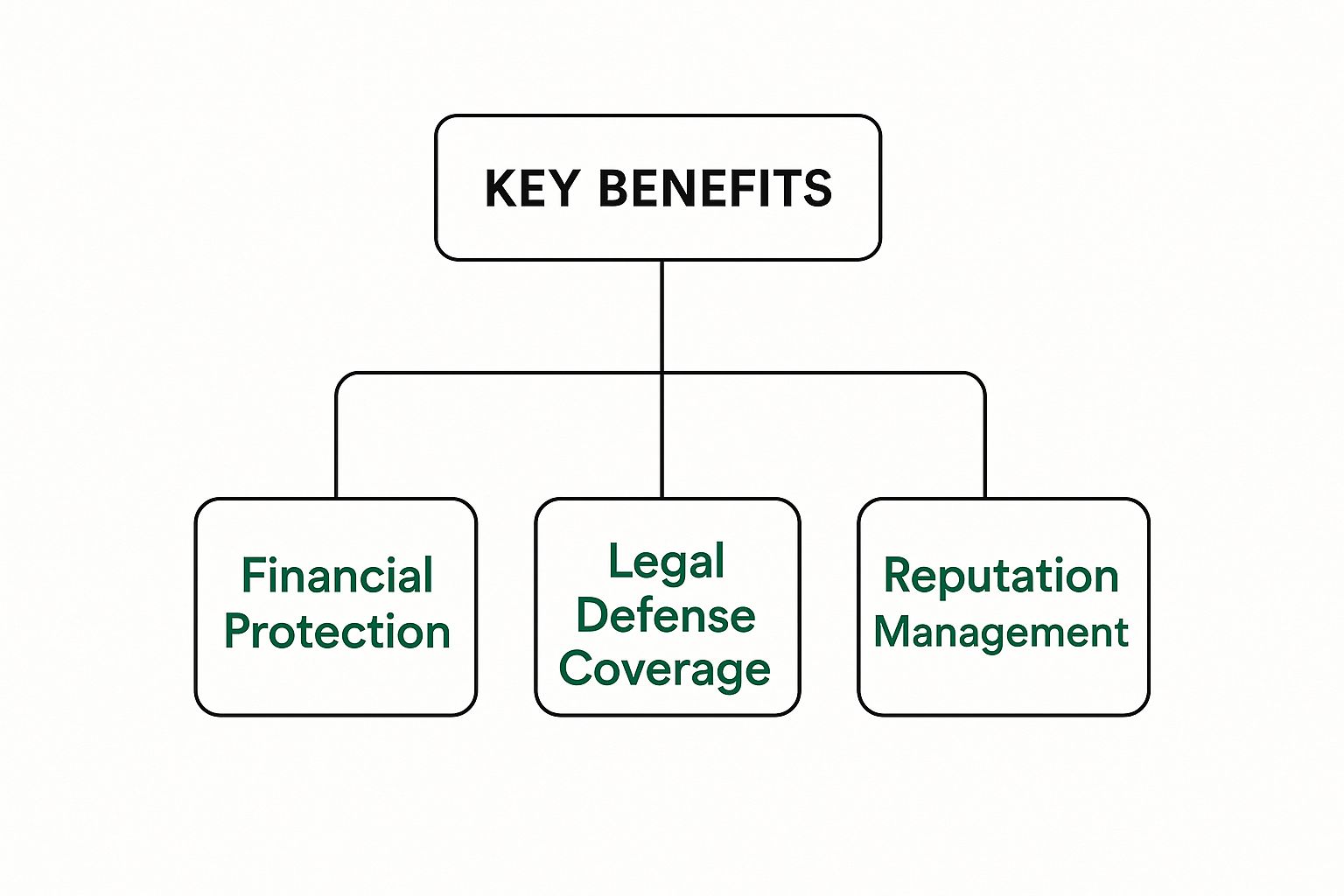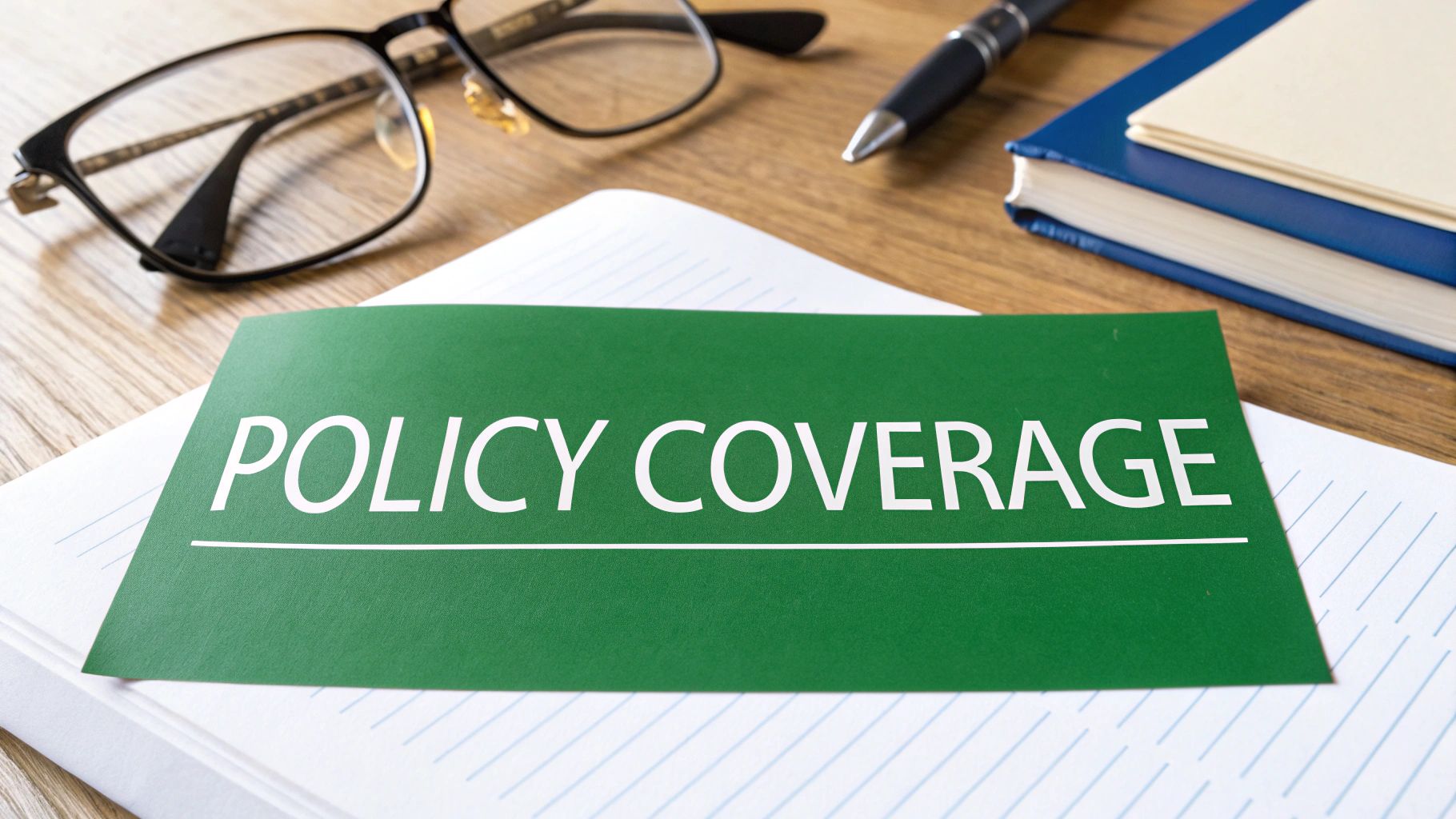If you're in charge of your company's employee benefit plans, you've taken on a massive responsibility—one with serious personal financial risk. Fiduciary liability insurance is a specialized type of coverage designed specifically to protect the personal assets of the people managing those plans.
Think of it as a professional safety net for anyone overseeing retirement funds like a 401(k) or employee health plans. It’s there to shield you from claims of mismanagement, errors, or a breach of your duties.
The Guardian of Your Employees' Benefits
When you manage your employees' benefits, you are legally considered a "fiduciary." This isn't just a title; it's a legally binding duty to act solely in their best interest, managing their benefit assets with care and prudence. This standard is set by the Employee Retirement Income Security Act of 1974 (ERISA), and the stakes are high.
Even an honest mistake or a simple oversight could trigger a lawsuit that puts your personal wealth—your home, your savings, your investments—on the line.
This is precisely where fiduciary liability insurance steps in. It’s not a luxury reserved for massive corporations. Any business, big or small, that offers benefits has fiduciaries who face these risks. Before diving deeper, it's helpful to see how this fits into the bigger picture of what insurance cover a company should consider. This policy is built to handle the high costs of defending against claims and paying out any settlements or judgments.
To quickly break down the basics, here’s a simple overview.
Fiduciary Liability Insurance At a Glance
| Key Aspect | Simple Explanation |
|---|---|
| Who It Protects | The personal assets of individuals managing employee benefit plans (the "fiduciaries"). |
| What It Covers | Legal defense costs, settlements, and judgments from claims of mismanagement or errors. |
| Why It's Needed | ERISA holds fiduciaries personally liable for losses to a benefit plan. |
| Common Claims | Poor investment choices, conflicts of interest, administrative mistakes, or bad advice. |
Ultimately, this coverage ensures that a simple human error doesn't lead to personal financial ruin.
What Makes This Coverage Unique?
Unlike a general business policy, fiduciary liability insurance is laser-focused on the management of benefit plans. It tackles the unique risks that come with the decisions fiduciaries make every day.
Here’s what it really does for you:
- Protects Your Personal Assets: If a court holds you personally liable for a plan’s losses, this policy can pay the judgment. That’s the difference between the company taking a hit and you losing your house.
- Covers Crippling Legal Defense Costs: Lawsuits are incredibly expensive. This coverage pays for lawyers' fees and court costs right from the start, even if the claim is baseless and gets thrown out.
- Addresses Simple Administrative Errors: Mistakes happen. Maybe someone was enrolled incorrectly or given flawed advice about their benefits. This policy is designed to respond to those very real, human errors.
A fiduciary's duty is one of undivided loyalty. This means every decision must be made with the sole purpose of benefiting the plan participants and their beneficiaries, not the company or the individual fiduciary.
This insurance is a vital piece of any company's risk management puzzle. It often works alongside other policies, and getting familiar with management liability coverage can give you a better sense of how these coverages protect a company's leadership team.
At the end of the day, it's about peace of mind. It allows you and your team to manage employee benefits confidently, without the constant fear that one misstep could lead to financial disaster.
Who Is Considered a Fiduciary in Your Business?
It’s a common misconception that only the CEO or CFO holds the title—and the risk—of a fiduciary. The truth is, the circle of responsibility is often much wider than business owners realize. Understanding who qualifies as a fiduciary is the first and most critical step in managing your company's risk.
So, what’s the real test? It boils down to function, not job title. Anyone who has discretionary control or authority over an employee benefit plan is likely a fiduciary. This isn't just about making the big-picture decisions. Even seemingly small, everyday actions can place you in this high-stakes role.
If you’re involved in choosing plan providers, selecting investment options, or even just advising employees on their benefits, you have probably stepped into a fiduciary capacity.
Identifying Fiduciaries in Your Organization
Take a moment and think about every team member who interacts with your employee benefits. You'll probably find that the list is longer than you initially thought, often stretching across multiple departments.
Here are some of the most common roles that carry fiduciary duties:
- Company Executives and Officers: These are the people with ultimate authority over the plan's existence and overall structure.
- Human Resources Managers: They are on the front lines, handling plan administration, employee enrollment, and communications.
- Members of a Benefits or Investment Committee: Anyone formally appointed to a group that makes decisions about the plan is a clear-cut fiduciary.
- Anyone Who Appoints Other Fiduciaries: This is a crucial one. The very act of selecting a committee member is a fiduciary function itself.
Fiduciaries often find themselves navigating complex employee benefit plans. A prime example is managing a workplace pension. To get a better handle on the intricacies of workplace pension schemes, digging into the details can highlight the immense responsibility these individuals carry.
The most important thing to remember is this: fiduciary status is about the role you play, not the title on your business card. If you have any influence over plan assets or how the plan is run, you could be held personally liable for a breach of duty.
A Realistic Scenario of Fiduciary Action
Let's paint a picture. Imagine your company's benefits committee gathers to review the 401(k) plan. An HR manager presents research on three potential investment advisors. After a spirited discussion, the committee—made up of the CFO, the HR manager, and a senior operations lead—chooses a new firm to manage the plan's assets.
In that single meeting, every single person in that room performed a fiduciary act.
They exercised discretionary authority by selecting an advisor, a decision that directly impacts the plan. If that advisor later turns out to charge excessive fees that eat away at employee retirement savings, the committee members could find themselves named in a lawsuit for making an imprudent choice.
This is exactly where a solid insurance policy becomes a lifeline.
As you can see, a good policy branches out to cover financial security, legal support, and reputational defense, creating a comprehensive shield. This really brings home why understanding what is fiduciary liability insurance is so vital for anyone in these roles—it’s designed to protect their personal assets when things go wrong.
What Does Fiduciary Liability Insurance Actually Cover?
So, you’re looking at fiduciary liability insurance. It’s easy to get lost in the jargon, but what does a policy actually do when a claim lands on your desk? Think of it less like a generic insurance policy and more like a specialized financial toolkit, built specifically to handle the legal and monetary risks that come with managing employee benefits. Its main purpose is to put a solid wall between your personal assets and the crushing costs of a lawsuit.
At its heart, the policy covers the two things that can sink a business (or an individual) during a legal fight: defense costs and damages. Let’s be clear: even a completely frivolous lawsuit can cost a fortune to fight. The bill for attorneys to defend your decisions can quickly climb into the six figures. This is where your fiduciary liability policy jumps in, covering those legal fees so your company—and you—don't have to drain your bank accounts.
Breaking Down the Core Coverage
A good fiduciary liability policy is designed to protect against a whole range of allegations. We’re not just talking about massive fraud accusations; coverage often extends to the everyday human errors and administrative oversights that can happen in any busy company.
Here’s what’s typically covered:
- Breach of Fiduciary Duty: This is the big one. It kicks in when plan participants claim you didn't act in their best interests. A classic example is getting sued for choosing high-fee investment funds for the 401(k) plan, which ate away at employees' retirement savings.
- Administrative Errors and Omissions: Simple mistakes can have big consequences. This covers things like forgetting to enroll a new hire in the health plan, failing to update a beneficiary after a life event, or giving someone incorrect information about their benefits.
- Improper Advice or Counsel: If your HR team gives an employee guidance about their benefits that turns out to be wrong, this part of the policy is there to respond if that employee sues for damages.
It’s crucial to understand that this coverage is very specific. It’s not the same as other business policies. To see how it differs, check out our guide on what errors and omissions insurance is, as E&O focuses on mistakes made in your professional services, not in managing benefit plans.
Covered Claims vs. Uncovered Exclusions
Let's make this real with a couple of scenarios.
Imagine your employees file a lawsuit claiming the company’s 401(k) plan was loaded with imprudent, expensive investment options. That’s a textbook covered claim. The insurance would pay for the lawyers to defend the company and its fiduciaries, and it would cover any settlement or judgment.
Now, contrast that with a situation where a plan manager is caught intentionally stealing money from the pension fund. This kind of deliberate, fraudulent act is almost always excluded. The policy is there to protect you from honest mistakes and accusations of negligence, not from criminal behavior.
The global market for fiduciary liability insurance is booming, projected to reach around $6.24 billion by 2033. This growth isn't surprising—it's a direct response to increasing government oversight and a growing awareness of the serious risks fiduciaries face every day. You can find more details in the fiduciary liability insurance market report on dataintelo.com.
When it comes down to it, the real-world value of this policy is its power to absorb the astronomical cost of a legal defense. Fiduciary lawsuits are expensive, draining, and incredibly stressful. Having this coverage means you can mount a proper defense without risking your personal financial future. That peace of mind is invaluable.
Real-World Claims That Trigger Fiduciary Policies
It’s one thing to talk about risk in the abstract, but it’s another thing entirely to see how these situations play out in the real world. Fiduciary liability claims aren’t just theoretical dangers; they are tangible, often costly, scenarios that can blindside a company.
What’s scary is how they often begin—a seemingly routine business decision or a minor administrative oversight that quickly snowballs into a full-blown legal battle.
Looking at a couple of common examples really drives home what fiduciary liability insurance is designed to cover and why it’s so critical for any business offering benefits.
The High-Fee 401(k) Lawsuit
This is one of the most common—and most expensive—claims we see. Picture this: a group of employees bands together and files a class-action lawsuit. Their argument? The company’s 401(k) plan is loaded with high-fee investment funds that have been slowly eating away at their retirement savings for years.
They claim the company's benefits committee, acting as fiduciaries, dropped the ball. They failed in their duty to vet the plan and choose more prudent, lower-cost investment options for their employees.
The plaintiffs don't have to prove anyone acted maliciously. All they need to do is show negligence. Just defending against a claim like this can be astronomically expensive, with costs for attorneys and expert witnesses piling up. A settlement or judgment could run into the millions to make the plan whole. This is exactly when a fiduciary policy kicks in, covering those defense costs right from the start and paying out any eventual settlement.
And this isn't a rare occurrence. After 48 excessive fee lawsuits in 2023, the number jumped to 65 in 2024. These figures have remained high ever since a 2022 Supreme Court decision made it easier for employees to bring these cases forward. You can see more on these trends and how they are impacting the fiduciary liability insurance market in 2025 on aon.com.
The Simple Administrative Error
Not every claim is a multi-million dollar class action. Sometimes, a simple human error can be just as damaging.
Imagine an HR manager mistakenly tells a new hire that their health insurance is effective immediately. Believing this, the employee puts off buying a private policy to cover the gap.
A month later, that employee has a medical emergency and racks up huge hospital bills, only to get the gut-wrenching news that their enrollment was never processed. They were uninsured the whole time. The employee then sues both the company and the HR manager personally for the cost of their medical bills, claiming they suffered a huge financial loss because of the bad information they received.
A fiduciary liability policy is designed to respond to claims of administrative errors and omissions. It protects against the financial consequences of mistakes made in the day-to-day management of benefit plans.
In this scenario, the policy would step up to pay the legal fees and fund a settlement to cover the employee’s bills. Both of these examples, big and small, show how this coverage is less of a luxury and more of a necessity. It’s a core component of the risk management best practices we recommend to all our clients.
How Fiduciary Liability Insurance Premiums Are Calculated
Ever wonder how an insurance carrier actually lands on a specific number for your premium? It's not a shot in the dark. For fiduciary liability insurance, underwriters essentially act like financial detectives, piecing together a detailed picture of your company's risk profile.
Think of it like getting a quote for life insurance. The insurer looks at your health, age, and lifestyle to figure out the risk. Similarly, a fiduciary liability underwriter examines the financial "health" and complexity of your employee benefit plans to set a price.
The most significant starting point is almost always the size of your plans. An underwriter’s first question will be about the total assets under management. It’s simple math, really—a company overseeing a $50 million 401(k) plan is a much larger financial risk than a company managing a $2 million plan. More money at stake means bigger potential losses if something goes wrong, which naturally leads to higher potential claims.
But it's not just about the total dollar amount. The number of employees participating in the plans is another key piece of the puzzle. A larger group of participants, even with smaller individual balances, significantly raises the odds of facing a class-action lawsuit.
Key Factors That Drive Your Premium
Once the basics are covered, insurers drill down into the nitty-gritty of your plan design and governance. Some features can wave a red flag and drive up your costs, while strong, documented oversight can earn you a better rate.
Here are the primary factors they’ll be looking at:
- Plan Assets and Participant Count: As we said, bigger plans mean bigger exposure.
- Previous Claims History: If you've been sued for fiduciary missteps before, expect your premium to reflect that history. It’s a major indicator of future risk.
- Plan Features: Offering complex or riskier investment options, like company stock in the 401(k), will almost always increase the cost.
- Industry and Company Stability: A business in a volatile industry or one showing signs of financial instability might be viewed as a higher risk for plan mismanagement.
The best way to keep your premiums in check is through rock-solid governance. When an underwriter sees you have a formal investment committee, keep detailed meeting minutes, and follow a clear investment policy statement, it tells them you’re serious about managing risk.
How You Can Potentially Lower Your Costs
The good news is you're not just a passenger in this process. You can actively make your company a more attractive risk to insurers.
Start by formalizing your fiduciary processes. If you don't have a benefits committee, create one. Make sure it meets regularly and, most importantly, document everything. Those meeting minutes are your proof that you’re following a prudent, defensible process. This isn't just good practice—it's your best defense in a lawsuit.
It's also crucial to understand the nuts and bolts of the policy itself. For example, knowing the difference between your per-claim limit and your total aggregate insurance coverage allows you to choose the right policy limits for your needs. At the end of the day, a proactive, hands-on approach to managing your benefits plan can have a direct, positive impact on your insurance bill.
Choosing the Right Fiduciary Liability Policy
Finding the right fiduciary liability policy isn't like buying standard business insurance. You can't just pick one off the shelf and hope for the best. The devil is truly in the details, and what's hidden in the fine print can make or break your protection.
Think of it this way: when you're buying a parachute, you don't just look at the price tag. You need to know it's going to work when you pull the cord. It's the same with this insurance. The first thing to scrutinize is how the policy defines a "claim." A broad definition that covers everything from a formal lawsuit to a simple written demand or a regulatory investigation gives you much more robust protection. A narrow one could leave you exposed when you thought you were covered.
Next up are the coverage limits and the deductible. The limit has to be high enough to handle a genuine worst-case scenario, which includes not just a potential settlement but the eye-watering legal fees that come with it. The deductible is what you'll pay first, so it needs to be a number your business can actually absorb without causing a financial crisis.
Partnering with a Specialist Broker
This is not a job for a generalist insurance agent. The nuances of fiduciary liability are complex, and you absolutely need to work with a broker who lives and breathes this specific type of coverage. A true specialist acts as your guide and advocate. They know how to dissect confusing policy language, negotiate better terms on your behalf, and spot dangerous gaps in coverage.
A crucial part of their process should be a formal insurance gap analysis, which is designed to make sure the policy you buy is perfectly matched to the unique risks your business and its benefit plans face.
Your broker will also be your best resource for vetting the insurance company itself. They'll look at key indicators like an insurer's A.M. Best rating, which tells you a lot about their financial strength. This is non-negotiable, as fiduciary claims can take years to surface, and you need to be certain your insurer will still be around and able to pay.
As litigation risks climb, insurance carriers are getting much more selective. For 2025, most primary policies in the U.S. market are being capped at $5 million in coverage. While some specialized insurers might go as high as $25 million for the right kind of client, the market is tightening. Given that these claims can have a very long tail, an insurer's financial stability is paramount. You can learn more about the current fiduciary liability insurance market conditions on ajg.com.
Essential Questions for Any Insurance Carrier
Before you sign anything, you need to ask some tough questions. This isn't about being difficult; it's about being diligent. These questions will help you cut through the marketing fluff and understand exactly what you're buying.
- How, exactly, do you define a "wrongful act"? The wording here is everything.
- What are the specific exclusions? Ask for real-world examples.
- Does this policy provide "duty to defend" (where the insurer handles the defense) or is it "indemnification" (where you pay first and get reimbursed later)?
- Are costs related to voluntary compliance programs, like the VCP, covered?
- How does the policy kick in if we face an investigation from the Department of Labor or the IRS?
Taking the time to do this homework upfront is the only way to get a policy that actually delivers peace of mind when you need it most.
Frequently Asked Questions
When you're managing employee benefits, it's natural to have questions, especially when it comes to personal liability. Let's clear up a couple of common points of confusion around fiduciary liability insurance.
What Is the Difference Between ERISA Bonds and Fiduciary Insurance?
This is a big one, and it's easy to mix them up. The simplest way to think about it is who—or what—is being protected.
An ERISA fidelity bond is required by law and is there to protect the benefit plan itself. Think of it as theft insurance. If someone who handles the plan's money acts fraudulently or dishonestly, the bond pays the plan back for the loss.
Fiduciary liability insurance, on the other hand, protects the personal assets of the fiduciaries—the people making the decisions. If you're sued for mismanaging the plan or breaching your duties, this policy covers your legal defense, settlements, and judgments. The bond protects the plan's money; the insurance protects you.
Does General Liability Insurance Cover Fiduciary Claims?
In a word: no. A standard Commercial General Liability (CGL) policy is designed to cover things like bodily injury, property damage, or advertising injuries. It almost always has a specific exclusion for claims related to managing employee benefit plans.
Trying to rely on your general liability policy for a fiduciary claim creates a massive, and frankly, dangerous gap in your protection. You absolutely need a dedicated fiduciary liability policy to handle these unique risks.
Navigating the complexities of business insurance is our specialty. At Wexford Insurance Solutions, we provide clear guidance to ensure you have the right protection without any gaps. Contact us today for a comprehensive policy review.
 Does Homeowners Insurance Cover Fences?
Does Homeowners Insurance Cover Fences? Difference Between Broker and Agent Insurance: Key Differences
Difference Between Broker and Agent Insurance: Key Differences









